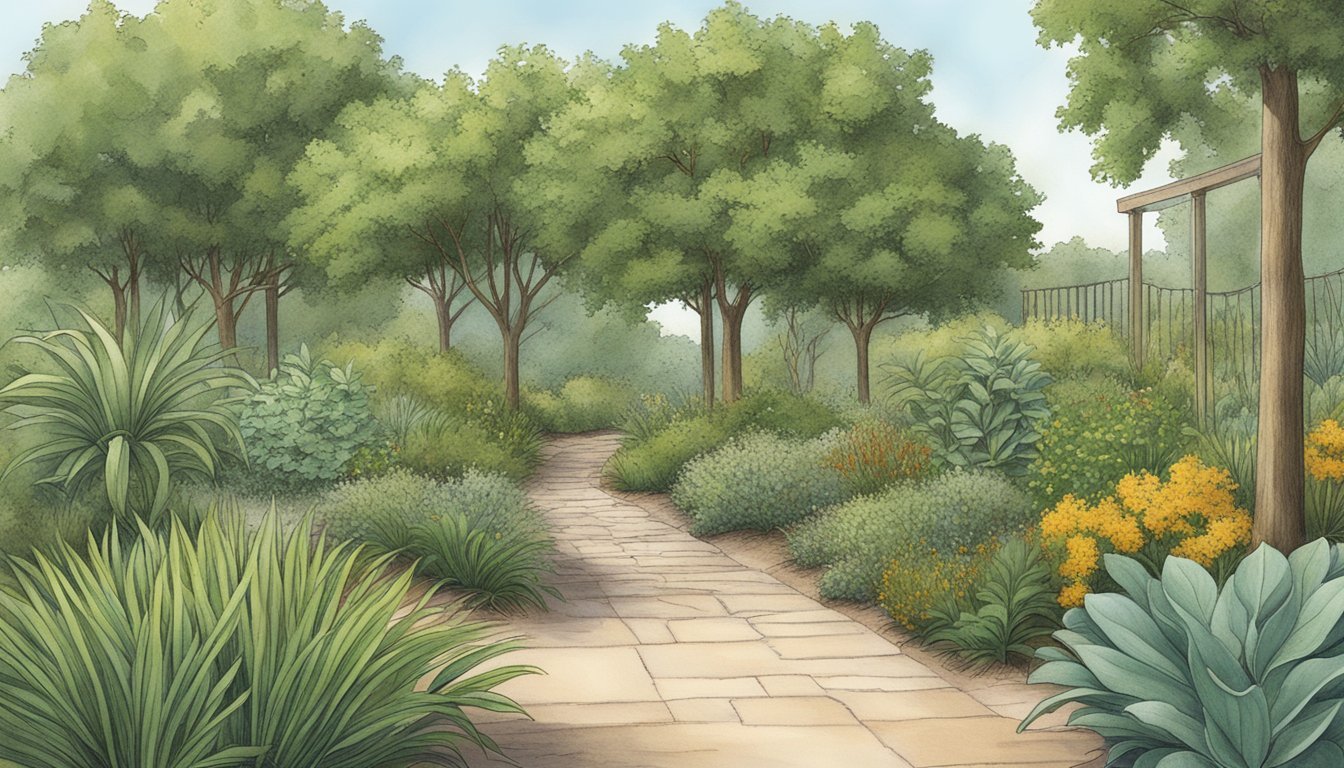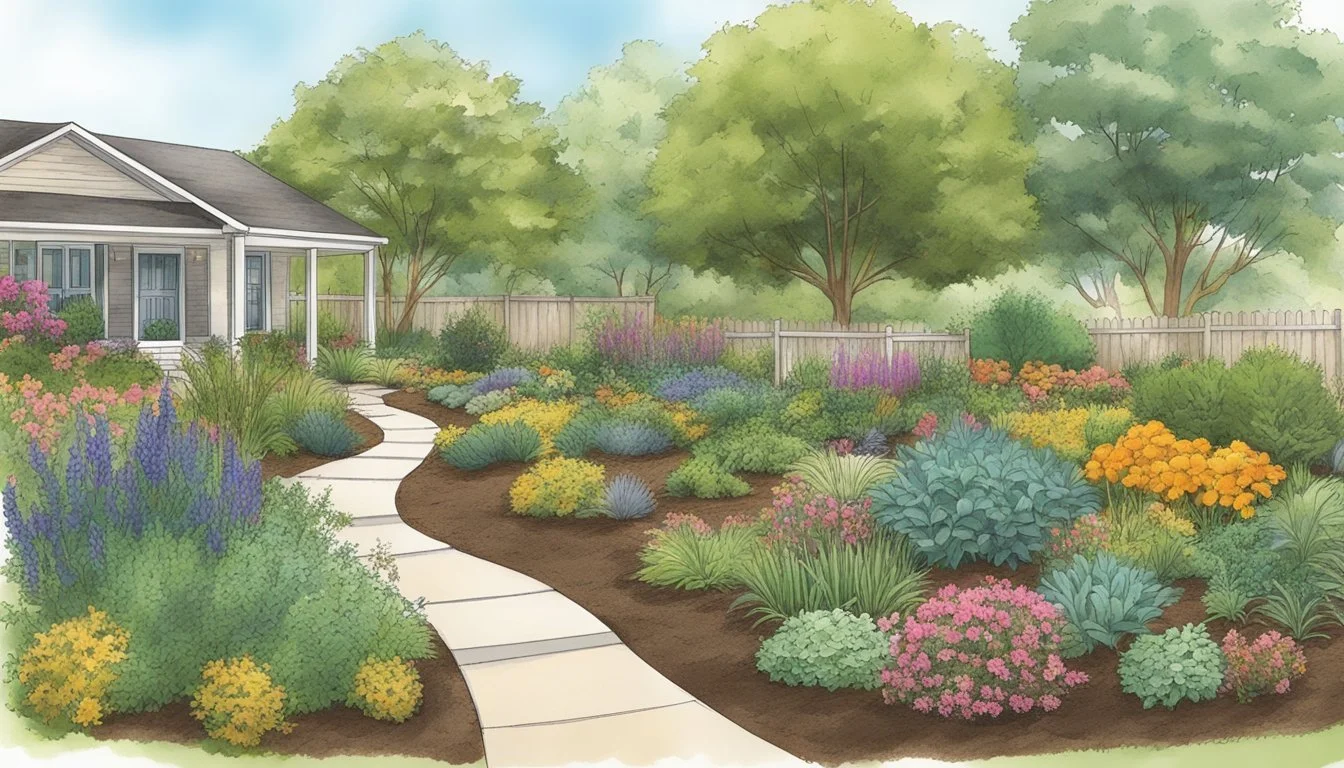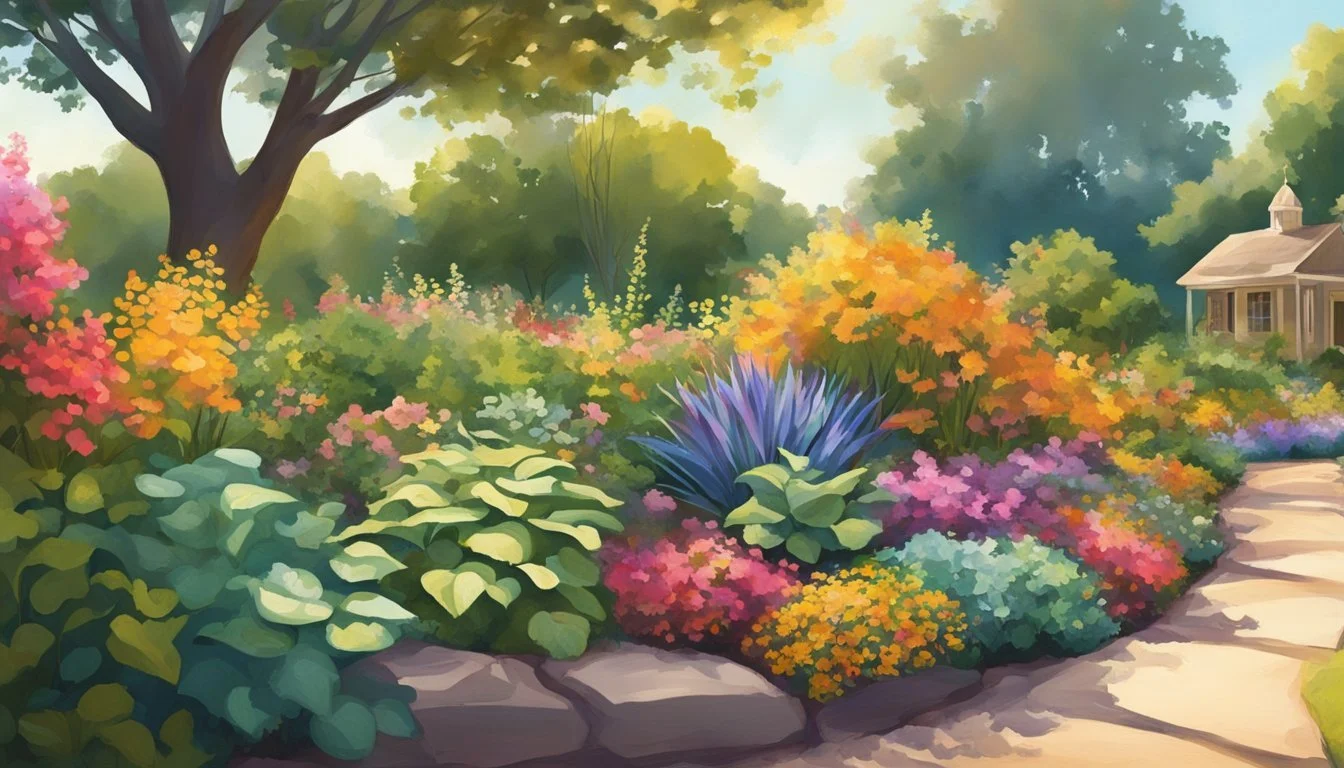Drought-Tolerant Plants in Mississippi
Thriving in Arid Conditions
Drought-tolerant plants are an essential component for sustainable horticulture in Mississippi, a state where weather can transition from heavy rains to prolonged dry spells. These resilient species offer practical solutions for gardeners and landscapers seeking to maintain verdant and vibrant gardens while conserving water. The choice of plants adapted to Mississippi’s unique climate not only ensures a lower maintenance garden but also supports local ecosystems and biodiversity.
In navigating the challenges of gardening in a climate that can be unforgiving, the selection of native plants and drought-resistant varieties is a key success factor. Native plants have evolved to thrive in the local soil, drainage, and weather conditions of Mississippi and are vital in creating a sustainable landscape. Additionally, these plants often provide critical habitat for wildlife, including pollinators such as bees and butterflies, thereby enhancing the ecological value of the garden.
Utilizing drought-tolerant trees and perennials not only minimizes the need for supplemental watering but also reduces the garden's overall environmental footprint. Through careful plant selection, gardeners can curate a collection of species that not only survive but thrive under Mississippi's fluctuating moisture conditions. This approach allows for lush gardens that are both beautiful and water-wise.
Understanding Drought and Its Impact on Mississippi
In Mississippi, droughts affect not only the water supply but also the health of local plants and the success of landscaping efforts. The state is subject to fluctuations in climate, soil conditions, and water availability, all of which have significant consequences.
Climate Factors Influencing Drought in Mississippi
Mississippi's climate is characterized by hot, humid summers and mild winters. Precipitation patterns are influenced by various factors including the Gulf of Mexico, which can contribute to both moisture and drought through mechanisms such as hurricanes and thunderstorms. During summer and fall, high temperatures can increase evaporation rates, leading to decreased water availability and the development of drought conditions.
Soil Conditions and Water Availability
The soil in Mississippi varies widely, with some areas containing rich organic matter and others characterized by more clay-heavy or sandy compositions. Well-draining soil can quickly lose moisture without sufficient rainfall or irrigation, while soil high in clay can crack during long periods of drought. Mulching and other soil management practices can help conserve water and protect against evaporation.
Effects of Drought on Local Flora and Landscaping
Drought conditions pose challenges to Mississippi's flora, including garden plants, lawns, and native vegetation, which all depend on consistent water supply. Landscaping with drought-tolerant plants can minimize these effects. Plants that are native to Mississippi are often more drought tolerant and thus better suited for local gardens and landscapes.
The Importance of Drought Preparedness
With climate patterns showing variability, preparing for drought is crucial to sustain Mississippi's landscaping and ecosystems. Drought preparedness involves selecting appropriate plant species, developing efficient watering practices, and implementing irrigation strategies that optimize water use. This helps in reducing the water bill and conserving water resources during periods of reduced rainfall.
Characteristics of Drought-Tolerant Plants
Drought-tolerant plants in Mississippi exhibit various adaptations that enable them to survive in low-water conditions. These adaptations encompass efficient water conservation mechanisms, specialized root systems, resilient plant structures, and distinct visual traits.
Adaptations for Water Conservation
Drought-tolerant plants have developed strategies to minimize water loss. Their foliage may display a waxy coating or be covered with hairs to reduce transpiration. Some species adopt a rosette form, allowing them to collect and channel water more efficiently toward their roots.
Root Systems and Drought Survival
A key factor in drought survival is the plant's root system. Drought-tolerant species typically have deep and extensive roots that reach moisture deep within the soil. This allows them to access water unavailable to plants with shallower roots, enhancing their drought tolerance.
Resilient Plant Structures
Structurally, these plants are designed to retain water. The stems and leaves of succulents can store water, which is crucial during dry spells. Additionally, the physical makeup of shrubs and trees found in arid regions tends to involve reduced leaf size and thicker bark to prevent moisture loss.
Visual Traits of Resilient Flora
Visually, drought-tolerant plants often have green, fleshy leaves or stunning flowers with interesting textures. These features are not just for aesthetics; they also play a role in the plant's survival strategy by reflecting sunlight or trapping moisture.
Selecting Drought-Tolerant Plants for Mississippi Gardens
When curating a Mississippi garden with durability in mind, it is crucial to consider plants that thrive in hot, dry conditions and have the ability to withstand periods of limited rainfall.
Assessing Site Conditions for Planting
The foundation for a successful drought-tolerant garden begins with an assessment of the site's conditions. One should note the type of soil present, whether it is sandy with good drainage or heavy and more retentive of moisture. Additionally, areas of full sun exposure and sections that might experience poor soil conditions must be identified, as certain drought-resistant plants excel in these circumstances.
Choosing Plants for Different Seasons
In Mississippi, drought-tolerant plants should be selected not only for their resilience but also for their seasonal performance. For the summer, one might consider plants such as the vibrant black-eyed Susan or resilient coneflower. When planning for fall and winter, one may opt for evergreen shrubs that maintain their foliage and structure throughout the seasons, providing consistent visual interest.
Trees and Shrubs Suitable for Dry Conditions
A variety of trees and shrubs are well-adapted to dry conditions often found in Mississippi landscapes:
Trees: Species such as the Southern live oak and crepe myrtle are noteworthy for their drought tolerance and stately presence.
Shrubs: Gardeners might choose the bottlebrush for its striking flowers or the Juniper species for its evergreen foliage.
These selections are ideal for sustaining a visually appealing landscape with minimal irrigation once established.
Perennial Flowers and Ornamental Grasses
Perennial flowers and ornamental grasses can enhance any garden with their long-lasting beauty and minimal water requirements:
Flowers: Consider drought-resistant perennials like coreopsis, which flourish in well-draining soil amid the heat.
Ornamental Grasses: Maiden grass and fountain grass stand out as excellent choices for their adaptability and textural contrast.
By choosing these plants, gardeners can ensure a burst of color and sustained elegance in their Mississippi gardens, even in challenging climatic conditions.
Cultivating a Drought-Resistant Garden
Creating a drought-resistant garden in Mississippi involves strategic planning and the application of specific techniques aimed at conserving water while maintaining a vibrant landscape.
Garden Design and Layout Strategies
When designing a garden capable of withstanding drought conditions, the incorporation of native plants that perform exceptionally well in Mississippi is crucial. A garden should be planned in zones based on the water needs of different plants, with drought-tolerant varieties placed in areas that are hardest to water. Utilizing sloped areas, known as berms, can redirect and utilize rainfall to the garden's advantage.
Soil Improvement and Mulching Techniques
The soil's ability to retain moisture can be significantly enhanced by mixing in ample organic matter. For drought-resistant gardens, applying a layer of mulch around plants minimizes evaporation and keeps roots cool. The mulch should be organic, such as shredded bark or decomposed leaves, to gradually enrich the soil as it breaks down.
Efficient Watering and Irrigation Methods
An effectively designed irrigation system, like drip irrigation, targets the root zone of plants directly, ensuring that the water is delivered where it's most needed while reducing waste. Watering in the early morning or late evening reduces evaporation, and the use of timers can help ensure a consistent schedule.
Maintenance and Care for Drought-Resistant Plants
Drought-resistant plants still require regular care. It includes methods such as deadheading to remove spent blooms and pruning to encourage new growth. Low-maintenance practices are beneficial, as plants like lavender and beardtongue can thrive with minimal input, provided they are established and situated in an appropriate microclimate within the garden. Regular checks for plant health and soil moisture guide irrigation needs, ensuring that the garden receives just enough water and no more.
Environmental Benefits and Ecosystem Support
Installing drought-tolerant plants in Mississippi landscapes not only conserves water but also reinforces local ecosystems by supporting wildlife and encouraging biodiversity.
Attracting Pollinators and Supporting Wildlife
Drought-tolerant plants are vital in providing habitats and food sources for pollinators such as bees, butterflies, and hummingbirds. For example, the native Mississippi meadow serves as a vital resting and nesting ground for these creatures. By planting species like black-eyed Susans and purple coneflowers, residents contribute to a more robust pollinator population, which is essential for maintaining healthy ecosystems.
Reducing Water Consumption and Conservation
Drought-resistant flora significantly lower the need for irrigation, which in turn reduces water consumption and lowers water bills. Utilizing plants adapted to Mississippi's climate does more than make gardens low-maintenance; it also plays a role in water conservation efforts. Mississippi landscapes adorned with these plants require minimal additional watering, leading to a more sustainable environment.
Contributing to Biodiversity with Native Plants
Incorporating native plants into landscaping is a critical move towards preserving Mississippi's biodiversity. Native species are a foundation of local ecosystems and support a wide range of wildlife. A shift towards plants like longleaf pine and magnolia that are naturally drought-tolerant enhances ecosystem stability and integrity, promoting an environmental balance that benefits both residents and the natural world around them.
Plant Profiles and Care Tips
Selecting the right plants for Mississippi's climate means focusing on drought tolerance and native adaptability to ensure a thriving garden. This section provides essential care tips and profiles for a variety of plants well-suited to Mississippi's varied conditions.
Native Mississippi Species
Mississippi's landscape offers a rich variety of native plants that are well-adapted to the local climate and soil conditions. Two standout native species include the Eastern Redbud and various native pine species.
Eastern Redbud (Cercis canadensis): Known for its stunning pink flowers, the Eastern Redbud thrives with minimal irrigation once established. It prefers well-drained soil and full to partial sun.
Pines: Pine trees, such as the Loblolly Pine, are inherently suited to survive in Mississippi's drought conditions. They require little care once rooted firmly in the soil.
Drought-Tolerant Annuals and Perennials
For gardeners interested in plants that need minimal watering, several annuals and perennials fit the bill:
Salvia (Salvia spp.): These hardy perennials require little water and offer vibrant flowers that attract pollinators.
Lantana (Lantana camara): Heat-loving and drought-tolerant, Lantana thrives in Mississippi summers.
Blanket Flower (Gaillardia pulchella): Known for its bright and cheerful flowers, it's an excellent choice for dry, sunny areas.
Each of these plants needs well-draining soil and will provide long-lasting blooms with minimal care.
Succulents and Cacti for Southern Gardens
Incorporating succulents and cacti can add unique texture and interest to Mississippi gardens. These plants are superb for their low-water needs and architectural forms.
Aloe (Aloe spp.): With its fleshy leaves and medicinal properties, Aloe is as practical as it is beautiful. It prefers bright, indirect light.
Rosettes: Succulents, such as Hen and Chicks (Sempervivum tectorum), form attractive rosettes and are excellent ground covers in sunny spots.
Sedum (Sedum spp.): Offers a variety of leaf shapes and colors, thriving in tough conditions with minimal care.
These succulents and cacti typically prefer loose, gravelly soil and only occasional watering once established, making them a great choice for Mississippi landscapes looking to conserve water and reduce maintenance.
Common Challenges and Solutions
When cultivating drought-tolerant plants in Mississippi, gardeners frequently encounter issues related to pests and diseases, as well as challenges posed by extreme weather conditions. The key to overcoming these obstacles lies in adopting proactive management strategies and adapting to the local climate.
Managing Pests and Diseases
Gardeners should start with a focus on plant health to create a garden environment less vulnerable to pests and diseases. Integrating organic matter into the soil can improve plant resilience, enhancing their natural defense systems. Regular monitoring for common pests like aphids and implementing effective biological controls such as ladybugs can also play a pivotal role. In addition, choosing disease-resistant plant varieties and providing adequate spacing between plants for airflow helps mitigate the risk of diseases taking hold.
Dealing with Extreme Weather Events
Mississippi's climate can present extreme weather conditions ranging from intense heat and drought to high humidity and occasional snow, which both challenge drought-tolerant plants. It is essential to select plants that not only have a high drought tolerance but can also withstand local weather extremes. Employing mulch can retain moisture during dry spells, and protect roots from temperature fluctuations. In the event of unexpected cold snaps or snow, covering plants or using windbreaks can offer necessary protection from the harsh elements.
Frequently Asked Questions
When planning a garden in Mississippi, selecting plants that can endure periods of drought is crucial. This section addresses common inquiries on choosing resilient plants suitable for various garden zones in Mississippi.
What are the top drought-tolerant perennials for zone 7 gardens in Mississippi?
For Zone 7 gardens, perennials like Russian Sage and Coneflowers are excellent choices. They not only withstand dry spells but also add vibrant colors and textures to the landscape.
Which evergreen plants can thrive in Mississippi's drought conditions?
Evergreens such as Hollies and Junipers perform well under Mississippi’s drought conditions. These evergreens require minimal watering once established, offering year-round foliage and structure to gardens.
What are some low-maintenance drought-resistant plant options for Mississippi landscaping?
Sedum and Guara are low-maintenance options that resist drought. They have evolved to thrive with little care, making them ideal for easy upkeep in Mississippi landscapes.
Can you list full sun plants that are drought-tolerant for Mississippi's zone 9?
In Mississippi's Zone 9, full sun plants like Lantana and Blanket Flower are drought-tolerant and thrive in the intense heat. They are perfect for sunny spots that receive direct sunlight for most of the day.
What flowering plants are both suited for Mississippi's climate and drought-tolerant?
Flowering plants such as Black-eyed Susans and Coreopsis are well-suited for Mississippi's hot climate and are remarkably drought-tolerant, offering prolonged blooms even in arid conditions.
Which native plants are recommended for drought-tolerant landscaping in Mississippi?
Native plants such as the Southern Magnolia and Tag Alder are highly recommended for drought-tolerant landscaping in Mississippi. They are adapted to local conditions and provide ecological benefits for wildlife.









